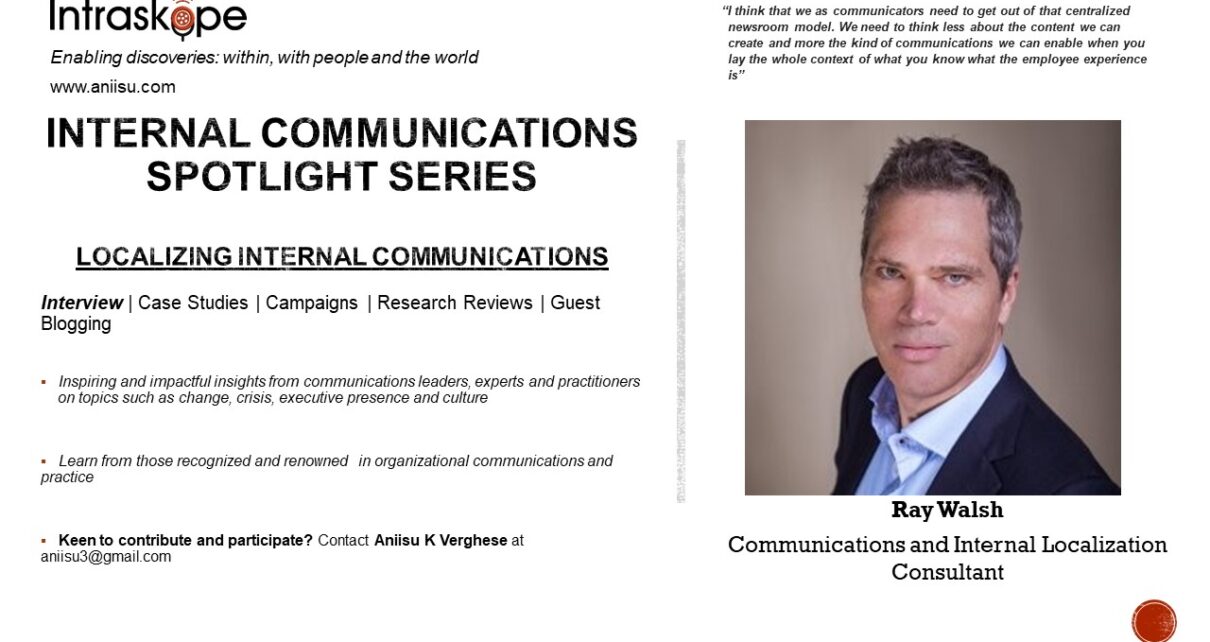Welcome to the 7th edition of Intraskope’s Spotlight Series featuring Ray Walsh, a former journalist and English language teacher, communications professional and author of “Localizing Employee Communications: A Handbook” (2020, XML Press/Content Wrangler). Ray, an American, is based in Prague, Czech Republic and focuses on content creation, audience awareness, localization, simplified English, training, and presentation support.
“it goes both ways communicators in the headquarters, as well as the communicators in the local office but speaking generally from the headquarters perspective, I would say, get to know the local network of communicators, whether they’re doing it, whether they’re fully dedicated or if they’re doing it just sort of on an ad hoc basis, get to know them personally meet them, find out what they can do, you know, you know, you never know that somebody has video editing capabilities, unless you actually get to talk with them so that’s number one.”, says Ray.
About Intraskope’s Spotlight Series
In this series I interview key thought leaders on topics interrelated with internal communications such as culture, crisis, change, executive presence and leadership. The goal is to help unravel why they matter, what can leaders and communicators learn from experts and how we can put insights to practice. Watch these short interviews and get better at understanding these key topics and how you engage with internal communications.
Interview
- You are an advocate for localizing employee communication. Isn’t that a given in multinationals? Why is it such a big deal?
Thank you for having me. It’s a pleasure to be here. My name is Ray Walsh, I have been a writer my entire career. I’ve been in corporate communications for the last 20 years. And most of that. I am American, from the central US, and I moved to Europe, I guess, about 13 years ago, so most of my corporate career is in fact that in Europe, and most of that has actually been outside of the corporate headquarters, supporting, supporting the global function but from a virtual place.
About 10 years ago, I got a job in corporate communications in a European headquarters, and they were the ones that introduced me to the concept of localization. To be honest, up until that point I thought of the communications department was the communications department and they are the CEO of all truths. But what we were doing at European headquarters was creating content and then we would hand it off to the countries, some of those countries had resources to manage the content, but many of them it was just our request was simply: localize this, do what do with it what you will translate it, if you will adapt it, if you will, but it was really we left it up to them.
And there was some mixed success with that the countries that were able to manage it, or able to, but many of them were not they didn’t have the resources they didn’t have the time because we didn’t give them enough time, and they didn’t have the skills or background to really adapt content so companies, that was a little, just about 10 years ago and companies that I’ve been with or supported since I see a similar kind of approach that they just handed off to the countries, and it’s really up to the countries to or business units to manage it. And I think it really leads to some problems.
2. What are the biggest reasons for organizations not thinking of localizing employee communications?
In one of the firms I worked for, I was told “everybody’s educated, everybody speaks English”. We really don’t need to manage multiple language versions at all. And a few weeks later I went to their Belgium plant, and I sat down with the site director, and I asked him about the corporate communications that he was receiving from us for employees and he looked confused. He said, I don’t I don’t share any of that. And then he went on to explain that Belgium has a local labor law that says that mine level employee communications must be in local language. Right now, in fact I’ve since I think he was maybe, maybe interpreting that law but strictly nevertheless it resulted in something that I’ve just recently started calling shadow localization. I’m borrowing the term from shadow IT and those are the IT solutions that people find, outside of the corporate network and shadow localization is really happening a lot more than I think corporate communicators realize, and in fact in that Belgium plan, because they didn’t share any of our global materials they created their own, they had their own newsletter. I could see just the visual look and feel wasn’t up to the company’s brand. And maybe that’s not such a huge problem. But, because they’re producing it on their own. Completely unbeknownst to corporate, they’re also missing out on and I think this is something I’ve heard you write about. And that is there outside of best practice, and sometimes local business units get sued because they use an image from the internet because they didn’t understand usage rights. So, the company is really at risk for being off message off brand, maybe even in legal troubles. Most American multinationals don’t want to spend a lot of money on internal communication and localization adds a level of complexity, it may add expense and they just really would rather not bother with it. But it’s a budget is an issue, but I think maybe the main issue is that the headquarters mentality. They’re really not used to collaboration, they’re used to creating broadcasting and everybody else has to take, they’re used to cooking and cooking and cooking and cooking these initiatives for a very long time, and then they get delayed because they go through approvals, and then there’s time pressure and they just push it out, not giving a reason because as soon as enough time to really react.
3. How can it be fixed? What is the mindset change needed?
I think it is really a mindset and I come from a journalism background and I come from a time when Corporate Communications really was like a central newsroom, and it’s a great model but I really think that the world has shifted. Technology has shifted. And I think that we as communicators need to get out of that centralized newsroom model. We need to think less about the content we can create and more the kind of communications we can enable when you lay the whole context of what you know what the employee experience is. We’re asking for user generated content we’re expecting them to use channels like Yammer, and then all the software as a service functions that they’re using, like, I don’t know ServiceNow – which is Workday. These are available in multiple languages, which I think even lowers the interest in our content even more, because their whole experience can be much more local and in local language. I think, you know we’re as corporate communicators, we’re a bit behind the times and then we need to catch up.
4. What was the genesis behind the book you authored on localizing employee communications? Did you see a gap in this area?
Well, that is exactly what the impetus was. Later I learned the word localization, as an industry, so I started to look at the industry. What can we as internal communicators, learn from them? For the most part I would say they’re focused on customers and sales communications and localizing selling products and supporting products all around the world. And they are much more ahead of us in terms of this this question. So, I originally started my research and interviews. What can we learn, and adapting content for language and culture? But over time, I’m realizing well actually there’s quite a bit of difference within a company just based on business.
You know, the, the automotive practice might be very have very different needs than the healthcare practice. So, you know so adapting it for the team level for the functional level, even if it’s all staying in English, there’s still quite a bit of localization going on and I think it’s still a very good question for us when we use computers to help line level managers make that adaptation. One of the people I interviewed told me that, younger people really grew up in a digital age where they expect interactivity, it’s really their expectations so I think that, channels like Yammer internal channels or even, external social, there is going to be that highly individualistic highly personalized highly participatory experience and I’m much more of a generation where we, we manage, and we were so my generation and previous was so concerned with message consistency, boring messaging discipline, and I still think that’s important and I think we have a, you know, we have something to teach communicators but I do think that we need to let go a little bit, and trust a little more. And really, and I think listened to those younger digital savvy people about what they expect.
5. Is there a way to measure the success of localizing employee communication?
I think the localization will be an investment. If, if not in actual money, certainly time. So, I think measurement is really critical. It’s important. And I think that the temptation. For those of us in corporate communications who come from content backgrounds. The temptation is for us to measure content. Content engagement, and if you know I saw this at my employer from 10 years ago when we did adapt to Germany and France, we did see an uptick in content and I think companies that take this on, will see more content engagement, but maybe that’s important, maybe it’s not. I think that you know an important question would be, business outcomes, and how can we be, how can we enable the business. You know what that company at the time, we were creating a lot of content around safety and then the importance of safety, but at the same time, there were a lot of accidents in India, that I kept happening and this is so, so something’s happening, you know, and the question is, what, what can we as communicators do. Now they had an award-winning series of posters on safety. Apparently the posters weren’t working and sometimes there was some kind of communication breakdown and clearly there was no language barrier in that company or even you know, being an English speaking country wasn’t understanding something else is going on so I think we need to get with the local management and find out how can we support, and of course, listen, you know, maybe Communications has no role whatsoever. I think the finding ultimately in the end, we will be a complement to what’s going on, but we won’t. We won’t be the driver of better safety results, but I think that in that conversation we can find we can mutually agree on some measurement, some baseline and we can establish,
6. What advice do you have for global communicators to think local?
So I guess it goes both ways communicators in the headquarters, as well as the communicators in the local office but speaking generally from the headquarters perspective I would say, get to know the local network of communicators, whether they’re doing it, whether they’re fully dedicated or if they’re doing it just sort of on an ad hoc basis, get to know them personally meet them, find out what they can do, you know, you know, you never know that somebody has video editing capabilities, unless you actually get to talk with them so that’s number one. And then the second most important thing is from the headquarters perspective is to involve them in planning. Even if you just have an idea, well we don’t know but in Q3. We’re thinking about possibly talk to them now about it and so get them thinking about what the possibilities are and involve them because they can alert, they can really prevent a lot of problems further down the road. And then also I think looking at from the other perspective the local countries. I don’t think they should be so passive and waiting for the perfect to come from headquarters and they should be much more questioning and more. The people in headquarters are famous for being out of touch and in their silos. However, they do know something, they know global company strategy, and they know best practice and I think if you look at them as partners, we can share best practice and local insight, and find the kind of the kind of collaboration that I think will be much more effective.
Watch the complete video interview on YouTube or read the transcript below.
Missed the earlier episodes? Watch them here: D. Mark Schumann (Culture), Peter Yorke (Executive Presence), Sia Papageorgiou (Leadership Communications), Dianne Chase (Strategic Storytelling), Gloria Walker (Communication Planning) and Rebecca Sangster-Kelly.
You can also look up the ongoing Intraskope’s Spotlight on Internal Communication Series featuring practitioners from around the globe sharing best practices and perspectives.
Liked the interview? Post your comments and share it with your network.
Keen to contribute and participate in the Spotlight series? Write to me at [email protected]
Here are Internal Communications resources you can use:
- Learn: Internal Communications Fundamentals Course on Thinkific or Udemy
- Internal Communications Series: https://forms.gle/KcqmPzLwq7NQi5Km6
- Chat with Aniisu – Internal Communications: https://www.instamojo.com/intraskope/connect-with-aniisu-60-minute-personalized-d/?ref=store
- Internal Communications workshops: https://bit.ly/2zdBRl1
You can also visit my website www.intraskope.com and You Tube channel to know more about my work.
#IC #localization #HQvsLocal #content #rapport #inspiration #trust #digital #openeness #empathy #internalcomms #communications #internalcommunications #leadership #covid19 #raywalsh #intraskope



